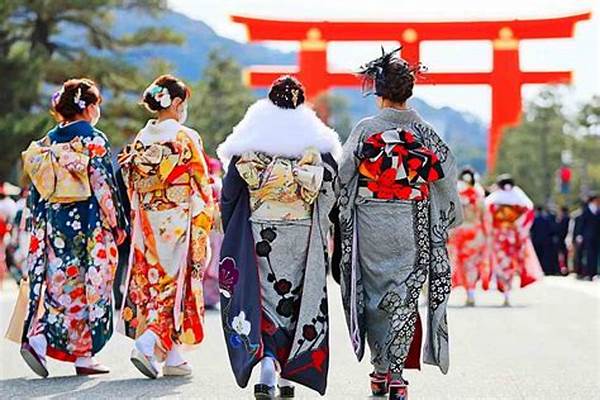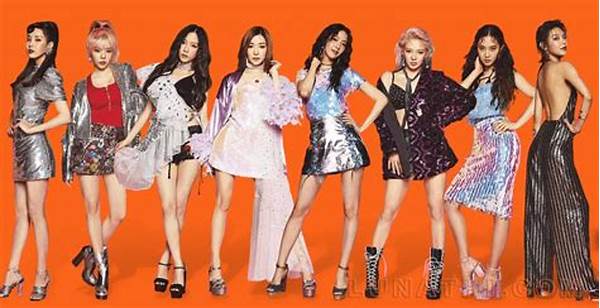Hey there, fashion enthusiasts! Today, we’re diving into the colorful world of Japanese fashion. It’s like a vast ocean with currents that change over time, creating waves in the global fashion scene. Are you ready to explore the Japanese fashion culture evolution? Let’s jump right in!
Read Now : Iconic K-pop Group Attire
Influences on Japanese Fashion Culture Evolution
Japanese fashion culture evolution is fascinating, right? It all started when traditional clothing like kimonos and yukatas began to meet Western styles back in the Meiji era. This cultural blend laid the foundation for a unique fashion landscape that continues to evolve today. In the city’s bustling streets, you’ll notice a fantastic mix of modern streetwear and traditional influences. It’s no surprise that Tokyo is considered a fashion capital of the world. The fusion of global trends with local styles keeps Japanese fashion fresh and exciting.
In recent decades, subcultures like Harajuku, Lolita, and Gyaru have driven the Japanese fashion culture evolution to new heights. These styles are not just about clothes; they’re about expressing identity and challenging norms. Designers have taken notice, too. Brands from Japan have increasingly gained international attention, and you’ll often see Japanese influences on runways around the world. Whether it’s through bold patterns or meticulous craftsmanship, the Japanese fashion culture evolution makes a mark everywhere it goes.
Key Elements of Japanese Fashion Culture Evolution
1. Street Style Vibes
Japanese fashion culture evolution thrives on street style. From Harajuku to Shibuya, it’s all about making a statement with daring and unique outfits.
2. Kawaii Aesthetic
The obsession with all things cute is a significant driver in the Japanese fashion culture evolution. Think oversized sweaters, pastel colors, and adorable accessories.
3. Traditional Meets Modern
Blending the old and new, the Japanese fashion culture evolution often incorporates traditional garments with a contemporary twist into daily wear.
4. Global Influence
Japanese fashion isn’t just local; it’s a global phenomenon. The evolution has led to reciprocal inspiration between international designers and Japanese trends.
5. Challenging Conventions
The Japanese fashion culture evolution encourages individuality, often breaking away from mainstream fashion through subcultures that defy conventions.
Unpacking the Subcultures in Japanese Fashion Culture Evolution
Let’s talk subcultures, shall we? They’re like the backbone of the Japanese fashion culture evolution. Harajuku is probably the first thing that comes to mind—those vibrant streets filled with young people expressing themselves through extreme and creative styles. It’s not just about looking good; it’s about being a part of a community. The Lolita style, inspired by Victorian and Rococo fashion, is another standout. It’s as much about lifestyle as it is about the clothes.
But that’s not all. The Gyaru movement, with its glamorous and bold take on fashion, adds yet another layer to the Japanese fashion culture evolution. It’s fascinating how these subcultures often start small and then explode into bigger trends both in and outside Japan. They not only influence what people wear but also impact music, art, and pop culture globally. Each subculture contributes its unique flavor to the sartorial landscape, making Japanese fashion an ever-evolving tapestry of style and self-expression.
The Global Impact of Japanese Fashion Culture Evolution
The impact of Japanese fashion culture evolution on the global scene is undeniable. Designers worldwide have been inspired by the boldness and creativity originating from Japan. Let’s delve into some examples.
1. Issey Miyake and his innovative fabric techniques have changed global views on textiles.
2. Rei Kawakubo’s works at Comme des Garçons challenge traditional fashion and inspire avant-garde designs.
Read Now : Key Pieces In K-pop Fashion Collection
3. Yohji Yamamoto’s minimalist aesthetic makes waves in major fashion capitals.
4. Japanese denim has created a cult following due to its quality and craftsmanship.
5. The Japanese streetwear impact is reflected in brands like Supreme collaborating with Japanese designers.
6. The incorporation of cultural elements has prompted the world to appreciate heritage within modern fashion.
7. Pop culture icons like Gwen Stefani and Billie Eilish have embraced the Japanese fashion flair.
8. Fashion weeks in Tokyo are eagerly anticipated by international buyers and media.
9. Japanese influence sees Western brands collaborating with Japanese artists and designers.
10. The presence of Japanese boutiques in cities like Paris and New York highlights the global reach.
The Emotional Side of Japanese Fashion Culture Evolution
It’s intriguing how deeply personal fashion can be. In the Japanese fashion culture evolution, every style choice tells a part of someone’s story. Fashion is a tool for expressing emotions, aspirations, and sometimes even rebellion. Remember those rebellious notes in the Harajuku or Gyaru styles? They’re not just clothes or accessories—each piece represents an emotional connection to identity and culture. Fashion becomes a trusted friend who helps navigate society’s complexities.
For many people, Japanese fashion culture evolution is about more than keeping up with trends. It’s about finding a style that resonates with who they are or who they want to be. Whether someone dresses up in a Lolita outfit because they adore the intricate details or they rock streetwear to reflect a more laid-back personality, the choices reflect an emotional layer of individuality. It’s heartwarming to see such authenticity in fashion, fueled by the willingness to let personal stories shine.
The Future of Japanese Fashion Culture Evolution
Japanese fashion culture evolution isn’t slowing down anytime soon. The future looks bright, with a continuous blend of technology and tradition. From high-tech fabrics to sustainable practices, the evolution continues to push the envelope. Expect more collaborations between Japanese designers and international brands, mixing diverse worlds into something new and exciting. Authenticity remains at the core, as does the desire to break the mold and set trends rather than follow them.
As we move forward, it’s likely we’ll see more fusion between digital culture and traditional fashion. Imagine virtual reality shopping experiences dressed in your favorite Japanese styles. The possibilities are endless, and it’s thrilling to think about what’s to come. Ultimately, the Japanese fashion culture evolution stands as a testament to creativity and innovation, with a promising journey ahead.
Wrapping Up: Japanese Fashion Culture Evolution
In summary, the evolution of Japanese fashion culture is a journey filled with rich history, diverse inspirations, and groundbreaking creativity. From blending traditions with modernity to the rise of influential subcultures, Japanese fashion continues to captivate and inspire people worldwide. Its ability to challenge conventions and embrace individualism sets it apart as a dynamic force within the global fashion scene.
The Japanese fashion culture evolution has influenced global trends, making an indelible impact on designers and fashion houses across continents. Whether through the emotional connection individuals feel with their chosen styles or the increasing focus on sustainability and innovation, Japanese fashion remains at the forefront of shaping contemporary fashion landscape. The future holds exciting possibilities for further evolution, and we can’t wait to see where this incredible journey will take us next!


